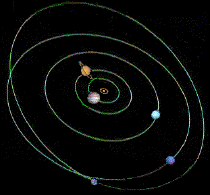 Reference
Reference
 Size
Contact
Size
Contact
Don's Home
 Reference
Reference
 Size
Contact
Size
Contact
|
Under Construction 
Outer Space | Inner Space (germs) The largest thing we know about, the universe (870 septillion [1024] meters) is a trillion, trillion, trillion, billion (1045) times larger than the smallest thing, a quark (1 attometer [10-18 m]) . Big Things
The cosmos is 13.7bn years old but the stretching of space with its expansion after the Big Bang means that simple distance measurements do not apply.
2. Pluto's orbit varies from 30-50 AUs from the sun. In 2003 a new planet, Sedna, was discovered with an orbit which varries from 76-850 AU in its 10,500 year orbit. It is nearly 97 AU away from the sun now. | ||||||||||||||||||||||||||||||||||||
3.Planets to Scale Jupiter is 142,796 km in diameter Reduction = 1 / 6 billion (109) (Distances between planets are not to scale.) |
Outer Solar System Pluto's orbit is 12 billion km in diameter. Reduction = 1 / 200 trillion (1012) | |||||||||||||||||||||||||||||||||||
Milky Way Galaxy Diameter = 100,000 light Years (1.4 quintillion [1018] km) | ||||||||||||||||||||||||||||||||||||
|
Small Things
* Note: micrometer (µm) is the preferred term but micron is still commonly used. † angström (Å) (10-10 m) was used in the older "CGS" (centimeter-gram-second) version of the metric system, but nanometers (nm) 10-9 is preferred in the newer "SI" (International System) version of the metric system.
A. milimeter mm
B. micrometer µm (or micron)- Dust - Cells | ||||||||||||||||||||||||||||||||||||
| ||||||||||||||||||||||||||||||||||||




Cell sizes vary greatly. Bacteria, single celled organisms, range from 0.2 to 20 µm;
E. coli cells are usually around 1 x 1 x 3 µm;
Yeast cells are little balls around 2 µm; in diameter.
Most human cells are roughly 20 µm; across, with nuclei about 10 µm; in diameter.
Red blood cells are about 7-9 µm, a human egg is 100 µm,
The wavelength of light is a bit shorter than one µm
A ray of light can only resolve objects that are larger than its wave length.
See: Resolving Power and Electron Microscopes below.
How big ? | celsalive.com

- A molecule with 60 carbon atoms is about 1 nm
A DNA molecule (chromosome) is 2 nm in diameter, but if streched out would be 1.8 meters long.
The largest amino acid, tryptophan, is about 1.2 nm long.
A water molecule is ~0.2 nm
The current (2005) Intel Pentium central processor contains over 3 million transistors with a minimum feature size of 350 nanometers. Other integrated circuits have feature sizes now at 130 nm and pushing toward 70 nm by 2010.
Molecule size is frequently measured by molecular weight or Daltons (Da.). One hydrogen atom has mass of 1 Da. Proteins and other macromolecule molecular weights are usually measured in kDa or kD (kilodaltons) - 1000 Da.
See Also: Basic Physical Scales Relevant to Cells and Molecules
D. A hydrogen atom is about 0.5 Å in diameter, a carbon atom is about 2 Å in diameter. Atom sizes are not proportional to the number of protons and electrons, because the extra protons in larger atoms have a stronger force to attract the electrons to smaller orbits.
Interactive demo of size at CellsAlive.com
Resolving Power
The human eye can recognize two objects if they are not closer than 0.1 mm at a normal viewing distance of 25 cm. This ability to optically separate two objects is called resolving power.
At 40x magnification you will be able to see 5mm. At 100x magnification you will be able to see 2mm. At 400x magnification you will be able to see 0.45mm, or 450 microns. At 1000x magnification you will be able to see 0.180mm, or 180 microns.
See microscopes
Electron Microscopes
Objects smaller than about 400 nanometers (wavelenght of violet light) will always be invisible to the human eye, because a ray of light can only resolve objects that are larger than its wave length.
The Scanning electron microscope (SEM) gets resolution down to 5 nm.
The transmission electron micrograph/microscope (TEM) is the prefered tool of biologists. It's resolving power is 3 nm. High-resolution versions can get down to 0.2 nm.
See Mediscan.
Scanning probe microscopy (SPM) is a generic term for a group of techniques that scan a fine probe (or tip) over a surface, either very close to the surface or just touching it, constantly or intermittently. Scanning tunneling microscopes (STM) and atomic force microscopes (AFM) allow you to image down to individual atoms (0.1 nm).
X-ray diffraction (XRD) can resolve things down to about 1/100 the size of an atom (one picometer).
D. The "size" of atomic and sub-atomic particles loses its meaning, because these "particles" behave as though they are waves, or wave packets. their masses are usually given in energy units of c2 from the Einstein relation E = mc2.
Physicists have determined an upper limit on the size of the quark to be 10-18 meters based upon data from high energy collisions.
Smallest theoritical limit:
Three of the most fundamental constants of physics are the gravitational constant, Planck's constant, and the speed of light.
Super Unification Theory (Gravitation unified with combined force and matter fields) predicts a natural end of space and time at 10-43 sec. and 10-35 m (Plank length) This is the Planck scale and time - space-time becomes quantized and gains infinite curvature, so that the classical concepts of space and time become meaningless. No faster times or shorter distances. There is one unified field.
There are some who believe that the next level of fundamental particle, if any exists, may be found at the incredibly small scale of the Planck length.
Size of Cells and Molecules
Hidden miracles of the natural world | Louie Schwartzberg - YouTube
Nanoscale Science, Engineering, and Technology Research (NSET)
Germs
How big ? | CellsAlive.com
Dimensions Guide